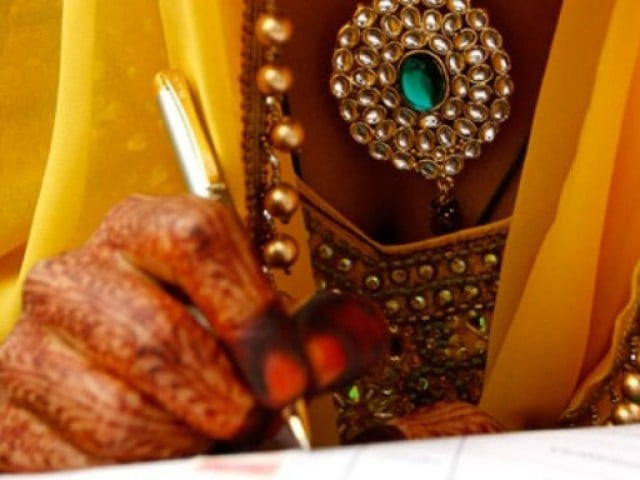When a marriage end: Bridal gifts, dowry become legal nightmare for litigant
Respondent’s ex-wife also files a suit for recovery of maintenance allowance

PHOTO: REUTERS
Respondent Muhammad Naveed claimed he had returned everything that belonged to his ex-wife in 2011 and settled the same through a mutual agreement but he was still being dragged into court of law for nothing. According to the respondent, some important aspects of the procedure had been ignored by the court in passing an ex-parte decree in favour of his former in-laws while the nonprofessional attitude of his own lawyer also ruined the case.
Kanwal Aziz, the daughter of advocate Mian Abdul Aziz, filed a suit for recovery of maintenance allowance, bridal gifts and her dowry articles in December 2009. The defendant was summoned by the court through ordinary process, failing which he was summoned through proclamation in a newspaper but he still did not turn up and then an ex-parte proceeding was initiated against him. The ex-parte decree was passed in favour of his ex-wife Kanwal Aziz. Later, Kanwal filed a petition in June 2010 praying the court to get executed the decree she had obtained.
Naveed filed his first petition in the court of family judge Qamar Abbas on April 30, 2011 praying to set aside the ex-parte decree against him. He informed the court about an agreement that all disputes were settled between the two parties and all the belongings were returned to the rightful owner. Meanwhile, Kanwal Aziz filed a preliminary objection petition responding to Naveed’s objections that the applicant/judgment debtor willfully avoided the service of notices adding the legal process was issued in accordance with law.
However, Naveed’s application for setting aside the ex-parte decree was dismissed on November 15, 2011. Later, he filed a revision petition against the ex-parte decree which was also dismissed on September 20, 2012. After that Naveed filed another petition on August 3, 2013 claiming the ex-parte decree be set aside as his lawyer did not professionally tackle the case and instead of defending his rights, his lawyer joined hands with his rivals. Hence the delay in filing this application was neither intentional nor deliberate. This application was also dismissed after which Naveed filed yet another petition under article 163 of the Qanun-e-Shahadat Order 1984 claiming his ex-wife and her father Mian Abdul Aziz were consistently denying the above said factum and were adamant to recover the same on the basis of ex-parte judgment and decree issued in April 2010.
In April, Judge Mian Nadeem Anjum had dismissed the request of the respondent about taking an oath by the both parties, saying it would delay the judicial process. Naveed moved to Lahore High Court and filed a writ petition praying the court to direct his ex-wife and her family to make a claim on an oath before this court that her belongings including gold ornaments were lying with the petitioner after October 25, 2009. This writ petition is pending with the LHC.
Talking to The Express Tribune, Naveed said legal procedure was not followed in the passing of the ex-parte decree and his lawyer ruined his case after he had joined hands with his ex-father-in-law advocate Mian Abdul Aziz. He said he was being humiliated by prolonging the matter despite he had prayed the court to take his oath first and then the family of his former in-laws to reach the actual point but his application was also dismissed.
When contacted, advocate Mian Abdul Aziz said the impression was wrong that the matter was lingering owing to his involvement and the court did not adopt legal procedure. He said courts work according to the law.
Published in The Express Tribune, September 27th, 2017.



















COMMENTS
Comments are moderated and generally will be posted if they are on-topic and not abusive.
For more information, please see our Comments FAQ